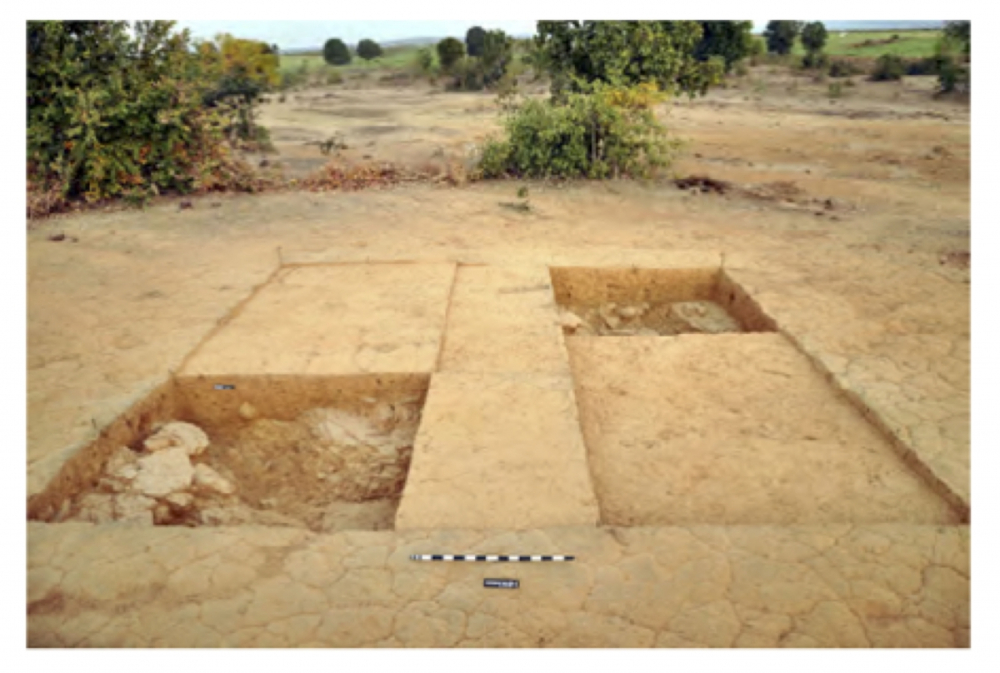The Acheulian sites in central India are considered to be some of the finest lower Paleolithic sites which yield evidence of early hominid occupation in India. This is manifest in the rock shelters of Bhimbetka, which show hominin occupational levels from Lower Paleolithic (Acheulian) to historical times.
The density of artefacts found here bears testimony to the rich cultural deposit of central Indian sites. These can be broadly classified into open air sites and rock shelter sites. Some are buried under alluvium soil like the rivers Narmada, Belan and Son. The concentration of open air sites is mostly in Raisen, Bhopal and Sehore districts of Madhya Pradesh. A few, such as Bhimbetka, Adamgarh, Mahadeo Piparia, Durkhadi Nala, Tikoda, Sihawal, Nakjhar Khurd and Samnapur are discussed here since they are studied in a wider context among Indian Acheulian sites.
Bhimbetka
The iconic site of Bhimbetka is one of the most important places of evidence of early hominin existence in India. Though it is not the earliest site to be found in India, it has accounted for the continuous presence of hominin habitation from the Lower Paleolithic to the historical period. It is situated in Raisen district of Madhya Pradesh and the Mumbai-Delhi central railway line passes near it. The word ‘Bhimbetka’ is a corrupt form of the Hindi word Bhimbaithka which means the sitting place of Bhima, the epic hero of the Mahabharata. The nearest tribal hamlet is Bianpur, etymologically another corruption of Bhimapur. It is 45 km south of Bhopal and 30 km north of Hosangabad.
The site of Bhimbetka was discovered by V.S. Wakankar in 1957. In the following years, he continued to explore the region and located over 600 rock shelters. He also brought to light stupa structures and early Brahmi inscriptions in the area. Systematic archaeological work was carried out from 1971. S.K. Pande and his associates from Sagar University made some trial pits in two shelters and found Mesolithic artefacts in shelter III F–24 and a Chalcolithic burial in shelter III F–14.
In 1972, Wakankar initiated archaeological prospecting for a period of six years. He excavated eight shelters (II B–33, III A–27, 28, 29 and 30, III F–16, 24 and 39) of which two, III A–30 and III F–24, yielded Lower Paleolithic assemblages and microliths while other shelters yielded artefacts from the Middle Paleolithic to Mesolithic period. V.N. Misra started excavation in shelter III F–23 in 1973. Four seasons (1973–1976) of excavation in this shelter yielded a continuous sequence of Stone Age culture materials ranging from those of Late Acheulian to Late Mesolithic period. In 1976–1977, Misra excavated shelters III F–13 and II B–33, both of which produced Mesolithic assemblages. Susanne Haas of Museum fur Volkerkunde located in Basel, Switzerland, excavated two shelters, III C-13 and III F-21, which yielded only Mesolithic culture.
V.N. Misra has classified the Paleolithic and Mesolithic assemblages from shelter III F–23, while S.N. Rajaguru has studied the Paleo environment and Malti Nagar has studied the ethno-archaeology of the region. Rock art has been studied in detail by V.S. Wakankar, Yashodhar Mathpal and Erwin Neumayer.
Acheulian deposits are best preserved and excavated in the III F–23 rock shelter. It has a deposit of 2.60 metres and has a continuous sequence of cultural materials from Acheulian to early historical periods. The Acheulian levels at III A–30 show a deliberate arrangement of large boulders to serve as an enclosure. At III F–23 and 34, there is evidence of flooring made by paving slabs.
The most extensively studied rock shelter amongst all the shelters is the III F–23 where 1,00,000 artefacts belonging to four cultural periods were excavated. 32,026 of these are quartzite and the rest are made of chalcedony, chert, agate and quartz. 18,721 of the quartzite artefacts are from the Lower Paleolithic period, 8,505 of the Middle Paleolithic, 2,522 of the Upper Paleolithic and 2,278 belong to the Mesolithic age. The important tool types reported from here are cleavers, hand-axes and scrapers.
These stone tools play an important role in understanding the behaviour of the early hominin groups as they show preferences in selecting raw materials. The overlapping of cultural materials shows the overlapping of cultural traits when the hominin groups evolved. The preference towards different types of stone tools, manufactured from time to time, can be also traced in the sequence of cultural levels classified into Lower Paleolithic, Middle Paleolithic, Upper Paleolithic and Mesolithic.
Adamgarh
The rock shelter site of Adamgarh is situated 2 km south of Hosangabad in Madhya Pradesh. Dr. R.V. Joshi had excavated the site in 1961–62 and the site provided an undisturbed cultural sequence from the Acheulian to the Mesolithic period. During the archaeological investigation, 18 trenches were opened and were named ADG 1 to ADG 18. Some of these are within the rock shelter and some outside. The Acheulian tools are found to be embedded in lateritic clay which yield both Lower Paleolithic and Middle Paleolithic artefacts. Except for a few instances, the entire tool bearing deposit seems to be entirely undisturbed. The Acheulian assemblage here consists mainly of hand-axes, cleavers, points, scrapers, flakes, choppers, cores, picks and debitage. Most of these artefacts are made of sandstone; there are some made from chunks of rock.
Of the total assemblage of 294 specimens, 35 per cent are made of pebbles or pebble flakes—the locally available raw materials. There are many unfinished tools which suggest that the site was a factory site. These unfinished tools include cleavers, hand-axes, scrapers, choppers and discoids. The richest tool bearing deposit was found at 150 cm in trench ADG 6; the successive layers showing a marked increase in the number of cleavers.
The excavation revealed an important aspect of Acheulian culture in India that the chopper occurs even in late Acheulian industry and not only in the early Acheulian period. The assemblages of the site are also indicative of the advanced nature of Acheulian industry in India.
Mahadeo Piparia
The site of Mahadeo Piparia is situated 24 km south of Narsinghpur in Madhya Pradesh and was discovered in 1961 by Khatri. It is famous for yielding the tool type ‘Mahadevian’ which is a chopping tool type comparable to the Oldowan of East Africa, which is considered a pre-Acheulian tool type. It is believed that the later Acheulian tool types were developed from this earlier type. Dr Supaker carried out excavations in between 1963–65. In 1963, an excavation trench was dug between the cliff and the present channel. It yielded 20,000 pebbles and boulders out of which 1,025 were artefacts. Of these, 802 were Lower Paleolithic artefacts made of quartzite; 223 were Middle Paleolithic and made of both quartzite and siliceous materials. However, there were no separate layers or stratigraphic divisions to demarcate the two assemblages.
This excavation revealed that there was an overall disturbance within the lower and middle Paleolithic tools found in the boulder conglomerate. Hence, it may be concluded that the earlier attempts to correlate geological deposits by archaeological means in the central Narmada valley are likely to be misleading and a complete reconsideration of the stratigraphy of the valley is imperative.
Durkhadi Nala
The prehistoric site of Durkhadi Nala is situated 2 km away from Maheshwar town located on the tributary stream of river Narmada. The site was discovered and excavated by Jorge Armand in 1970. It is 36 square metres of pebbly gravel deposit where 650 artefacts were excavated. The tools found were choppers, scrapers, proto hand-axes, burines, borers, cores, flakes and debitage of which nearly 70 per cent were cores, waste and unworked flakes. This definitely points towards the site being predominantly a workshop of lithic tools with very few early Acheulian bifaces.
Tikoda
Tikoda village is located 22 km from Raisen. Explorations near the village were first done in 1983 by the Archaeological Survey of India’s Nagpur branch. More recent investigations were also conducted by the Archaeological Survey of India and Deccan College, Pune. Their work led to the discovery of more than eight localities numbered TKD I to TKD VIII. Out of 220 artefacts, 94 per cent are made of quartzite and the rest are either chert or chalcedony. Typologically, the collection is dominated by flakes and cleavers with a few hand-axes. A 5x5 metre trench (TKD I) was laid down (Fig. 1) and eight squares were taken up for excavation. The total thickness of sandy-silt deposit with ferruginous pellets is 40 cm which is resting on bedrock. The artefacts collected here were flakes, one core and one cleaver. The locality of TKD II revealed clusters of artefacts in which cleavers dominated all other finished tools. (Fig. 2)

Fig 1: Archaeological excavation at Tikoda

Fig 2: Prehistoric stone artefacts at Tikoda
Sihawal
This prehistoric site is situated at village Sihawal in Madhya Pradesh, on the northern bank of river Son. It was excavated under the directorship of Dr J.N. Pal, Dr J.M Keyoner, Carole Sussman and Jo Ann Gutin of the University of California. The excavation was of a 5X5 metre area together with a 1X2 metre sondage, about 4 metres up-slope. The stratigraphy, which relates directly to the geological formation, is defined by geologists William and Royce. The total number of artefacts from trenches 3A and 3B is 119 of which 95 per cent are made of quartzite and fine-grained sandstone whereas 5 per cent are made of chert. 11.8 per cent of the artefacts are shaped tools including hand-axes, cleavers, choppers, end flakes, side flakes and core scrapers. Of these, 11.8 per cent are modified or damaged along the edges.
Nakjhar Khurd
The site of Nakjhar Khurd is situated on the right bank of river Son and is located 1.6 km south-west of Sihawal. It was excavated by V.D. Mishra of Allahabad University. The excavation revealed 14 layers of archaeological deposits in which there were three main units: Bagor, Sihawal and Patpara. Out of the 58 artefacts found, 21 were obtained from the gravel unit of the Sihawal formation. These included hand-axes, cleavers, picks, choppers, scrapers, polyhedrons, modified flakes, chunks and cores and were found to be in good condition. The feature of the gravel at the base level of the excavation reveals that it was formed by fluvial deposits, marking the existence of a water body in the area in the earlier times. The artefacts were found from all levels of deposits, which indicate a transition from one period to another.
Samnapur
This site lies on the right bank of river Narmada and Richai Nala, 1.5 km away from Samnapur village. The stone artefacts here have been exposed by the erosion of overlying silt. Three seasons of excavation revealed 3,192 artefacts. Unlike other sites, the main raw material used in the manufacture of artefacts here is cherty quartzite. A small portion of artefacts are made of Vindhyan quartzite pebbles and cobbles, found 10 km north of this site. This points toward the catchment area for raw materials of the hominin groups during this time. The freshness and the high concentration of artefacts, lack of imbrications and the presence of manuports imply considerable influence of human activity in the formation of rubbles on the site. Volcanic ash is also present 10 km away from the site which may be due to the tectonic movements in Indonesia.
These Acheulian sites of central India have been excavated to gain some insight into the general character of Acheulian culture in India. The assemblages from these sites show great potential for understanding early human existence in the Indian subcontinent. Unfortunately, many of these sites are under threat due to lack of understanding of the importance of their preservation. Since there are no obvious structures or conventional historical elements like monuments, most of them are encroached upon for agriculture, construction of buildings or quarrying soil for commercial purposes. Hence, the identification, understanding and protection of such sites are extremely important for their preservation.











